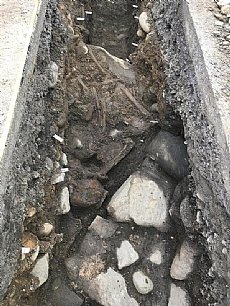Kingussie Friary
02 January 2020
- News Type:
- Site of the Month

Photo © Kirsty Cameron, Highland HER
Although Kingussie was a planned settlement dating from the 18th century, an early Christian church dedicated to St Columba was reputedly founded there much earlier. Documentary sources also record the founding of a Carmelite Friary in late medieval times. The exact locations of both sites was unknown, but recent work has found walls and burials which relate to the friary, and possibly also to the earlier church.
The Carmelites were an austere, mendicant order. There were 10 foundations in Scotland (11 if Berwick is included), although little is known about most of them, and virtually nothing about the Kingussie establishment. Kingussie appears to be one of the latest, probably in the late 1400s (Copesey 1998), and was said to have been founded by George, Earl of Huntley.
The walls of the lost friary were discovered during a watching brief in 2018, when the cutting of a water pipe trench along Mill Road adjacent to the cemetery disturbed human remains. Subsequent excavation work along the length of the trench uncovered two large sections of wall, complete with their lime-mortar bonding, which comprise the west gable and south walls of a building aligned north-south and east-west. This was highly likely to be the remains of the Carmelite Friary, which was projected to extend under the turning circle at the end of Mill Road and into the present enclosure marking St Columba’s cemetery (See figure 11of the 2018 Data Structure Report). Significant quantities of disarticulated human bones were uncovered within a structure built inside the church (built against the central area of the inner west gable) which was interpreted as an ossuary.

walls and human remains. Photo
© Kirsty Cameron, Highland HER
Despite the small nature of the excavation (confined only to the pipeline trench), important evidence was discovered. The human bone primarily comprised crania and long bones with few lower mandibles, teeth, vertebrae, ribs or other bone from extremities identified. Further deposits and human remains, extended below, appearing to underlie the church foundations. These may predate the Carmelite Friary and possibly relate to earlier funerary use of the site associated with the Columban church. The human remains from the ossuary type feature probably contained re-interments of disturbed human remains, perhaps from the construction of the church or digging of new graves.
A detailed programme of post-excavation work for the 2018 investigations has been recommended. The results of this, in particularly the radiocarbon dating of the structural features of the church walls, human remains and metal working residues, will form a data set of regional and national importance. Additionally, the watching brief undertaken here is another that confirms the long held suspicion that our missing medieval archaeological remains, and possibly early medieval remains, lie beneath our urban towns and cities. In the case of Kingussie, where there has been a high level of disturbance and destruction in the intervening years, far more appears to have survived than would perhaps have been expected. There is certainly scope for a larger scale excavation to try and determine construction dates, as well as information from the human remains, which would allow comparison to the excavations of the Carmelite friary in Aberdeen.
The site is also important about revealing the reach of monastic foundations in the Highlands. Unlike other areas in Scotland, few were established in the Highlands. The recent discovery of the remains of a little known Carmelite establishment at Kingussie provides important information about medieval religion in the area.
Further Information
Birch, S.. 2018. Water Main Replacement Scheme: Mill Road, Kingussie: Desk-based Assessment and Archaeological Watching Brief Data Structure Report. West Coast Archaeological Services. 20/12/2018. The report is available on the HER record, and provides a good discussion of the documentary evidence.
Copesey, Richard 1998. ‘Foundation Dates of Scottish Carmelite Houses,’ Innes Review. 49. 41-65. Available online
https://her.highland.gov.uk/Monument/MHG4413
https://her.highland.gov.uk/Event/EHG5228
Report contributed by Grace Woolmer and Susan Kruse
Site of the Month Archive
- 10/04/2021 Easter Raitts township
- 02/03/2021 Lower Slackbuie, Inverness (ASDA) Neolithic site
- 01/02/2021 Balnuaran of Clava cairns
- 04/01/2021 Wilkhouse Inn
- 02/12/2020 Spinningdale Cotton Mill
- 02/11/2020 Skibo A Canadian Forestry Camp
- 01/10/2020 WWI Detonator Store, Dalmore near Invergordon
- 03/09/2020 Mesolithic Shell Midden at Sand, Wester Ross
- 08/08/2020 Kinbeachie Neolithic settlement
- 01/07/2020 Armadale Cist Burial and Stone & Timber Complex
